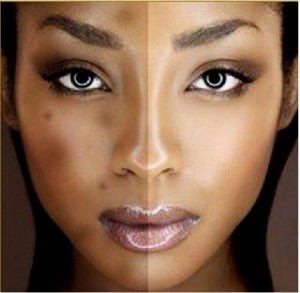Pigmentation & Brown Spots
Hyper pigmentation is one of the most frequent cosmetic complaints in the country and even more so in areas like where there are so many sunny days. Sun exposure is the light switch for this problem. Hyperpigmentation in its simplest explanation is an over-production of the natural pigment in your skin. The starting factor could be a genetic predisposition, sun exposure, or as a result of hormone changes or the use of birth control pills – as in the case of melasma or a “pregnancy mask” during and after pregnancy.
The major cause of splotchy skin and brown markings on the face, chest, arms and hands is sun exposure. No matter what terminology used – brown spots, melasma, age spots, “liver spots”, sun spots, blotchy skin or any other name – hyper pigmentation is a melanin response to some kind of trigger. A major component in preventing and controlling uneven pigmentation is the use of effective sunscreens. This becomes especially important during and following the various medical treatments used to reduce discoloration in the first place.
A wide variety of treatments are available for brown spots and hyperpigmentation. The cause of your hyper pigmentation will determine the most effective method to help lighten, blend and control the problem. During your consultation with Dr. Sikorski, she will ask questions about your background, work environment, sun habits and medication use to carefully determine the source of the problem and decide which treatment is most suitable and most effective for your particular skin color, skin type and skin problem. Lifestyle plays into the treatments. If you can’t or won’t stay out the sun, some procedures will just compound the problems.
Some of the more useful measures in treating brown spots and pigmentation:
- Cosmelan – An intensive topical treatment program that inhibits melanin production and lightens your skin with non-hydroquinone ingredients
- MIXTO Laser – A fast-healing laser treatment that has FDA approval for Melasma and Chloasma and Sun-induced hyperpigmentation
- Photofacial IPL – Intense light exposure to reduce red and brown skin discolorations
Chemical Peels – Over-all skin regeneration by chemically causing a peeling of your damaged skin
Sciton Skin Resurfacing Laser for intense pigmentation, though for certain skin types ablative lasers should be avoided
- Hydroquinone based lightening prescription creams
Retinoic acid topical gels or creams
What’s the role of melanin in hyper pigmentation?

Understanding the role of melanin allows us to understand how hyper-pigmentation works. The color of your skin, whether light or dark, is produced by melanin. Melanin is the a pigment produced by your body that determines the color of your skin, eyes and hair. The more melanin your body produces the more color and “color-potential” you have in your skin.
Specialized cells called melanocytes make up about five percent of the cells in your epidermis. When melanocytes are exposed to ultraviolet B light (short wave ultraviolet), they produce melanin which is the pigment responsible of a tan or melanin over production in the case of hype-pigmentation. The newly formed melanin moves up through the epidermis and is absorbed by other skin cells. When the skin is exposed to ultraviolet A light (longer wave), the melanin absorbed by skin cells oxidizes or darkens. The skin darkening is the skin’s natural way of protecting itself against too much UV light.
Everyone has the nearly the same number of melanocytes in their body – about five million. But your heredity dictates how much melanin your body’s melanocytes naturally will produce. For example, the skin of African-Americans contains enough melanin to create a black or brown skin color, while the skin of Caucasians has less melanin and is pale.
To a great degree, your ancestry determines how susceptible you are to having brown spots or brown patches on your skin. Most patients with Scandinavian backgrounds have little incidence of pigmentation problems. If, however, you are of Latin America, Middle Eastern or Asian descent, you will have more melanin cells and the likelihood of hyperpigmentation is significantly higher.
Major Causes of Hyper Pigmentation and Brown Spots
- Hyper-pigmentation from Sun Exposure: One of the primary functions of melanin production is to protect your skin from UV rays from the sun. A “tan” is a an example of your body’s melanin production in response sun exposure.
- When your skin is constantly exposed to the sun, you experience sun damage in a variety of ways. One of the most common signs of sun damage is the appearance of brown spots and hyper-pigmentation. This happens mainly because once the cycle of pigment over-production has started, it’s difficult to stop it and usually medical intervention is required.
- Hyper-pigmentation (Melasma or Chloasma) from Hormones: The second most frequent cause of hyper-pigmentation is hormone shift. The various stages of menopause, birth control pills or pregnancy can create changes in hormone levels that can trigger melanin cells to go into over-drive. This can happen even if you are not constantly exposing your skin to the sun. However, if you have hormone-related pigmentation problems, you still need to be careful with sun exposure since it will always make it worse.
- Hyper-pigmentation from injury (termed Post-Inflammatory Hyper pigmentation or PIH): The third most common cause of pigmentation is a direct result of some type of injury to the skin.
Common pigmentation-causing injuries include
- Acne or acne cysts
- Abrasions or cuts
- Insect bites or itchy rashes
- Over-exposure to heat
- Hair waxing
- Improperly performed laser treatments
How does injury create hyperpigmentation?
Your body’s response to injury is inflammation. Often you don’t even see the inflammation since much of it occurs beneath the epidermis. This inflammation triggers melanin over production resulting in color lines or stripes or brown patches.
Improper use and application of heat generating devices is a risk many people take when they frequent unsupervised medspas or medical offices that really don’t have training in skin and skin response. Lasers are medical devices and belong in a qualified medical office. In many cases throughout the country inadequately trained technicians in spas and stand alone unsupervised laser “clinics” have caused scarring, color changes and irreparable damage to their clients’ skin. Post inflammatory hyperpigmentation (PIH) is only one of the reasons you should always have medical treatments such as hair laser removal, photofacial, or any type of laser or light treatment performed in a dermatology office under the properly trained guidance of a board certified dermatologist.
Preventing and Minimizing the incidence of hyperpigmentation
Sun exposure is the #1 cause of facial and body brown spots, age spots, freckles, moles and pre-cancerous actinic keratosis. Protecting your skin from the sun is the only way to proactively preventing the majority of environmentally-caused hyper-pigmentation.
Sunscreen, sunblock, hats and sun-protective clothing are your first line guard against not only unsightly brown patches but also sun damage that could lead to skin cancer. Many causes of hyper-pigmentation such as injury, hormones and pigmentation from allergic reactions or skin disease such as acne are beyond your control, but you are always in control of how well you protect your skin from the sun.
Your consultation visit

You’ll enjoy a relaxing visit to our office where you can ask questions, meet our staff, take a tour of our office and surgical suite and view additional photo results of our patients.
Your consultation assessment is with Dr. Sikorski, not an impersonal or commissioned salesperson. Fees and procedure preparations are discussed with our patient coordinator, who will detail the surgical experience with you.
We look forward to meeting with you and helping you find the simplest solution to achieve the goals you desire. If you believe you suffer from pigmentation and brown spots in Orange County, call Dr. Sikorski for a consultation and recover the brightness of your skin. Call or use our online form today.
 contact us today
contact us today
